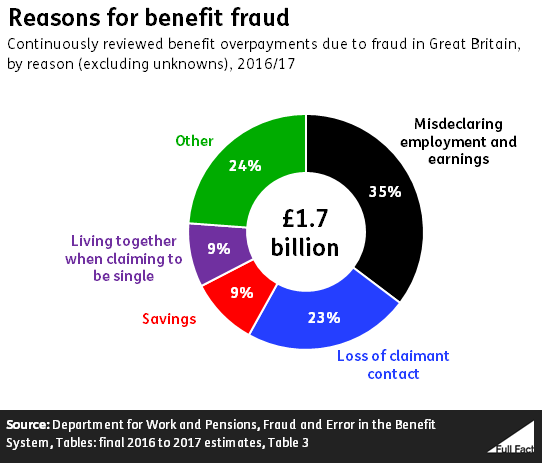Full Fact Points Out DWP Misreprentation of Facts
Saturday 17 February, 2018 Written by Full Fact
Just in time for Valentine’s Day, the Department for Work and Pensions reminded loved-up couples receiving benefits to declare their living arrangements. It said that people claiming to be living alone, when they weren’t, was one of the most common types of benefit fraud.
Looking at the cost of overpayments where benefit fraud has happened, about 9% was estimated to be down to claimants saying they were single and not informing DWP they actually lived with someone else and had a “joint household” in 2016/17. So this was probably the fourth most common type of benefit fraud that year, where the reason was known.
The figure includes the cost of fraud overpayments for Jobseeker’s Allowance, Employment and Support Allowance, Pension Credit, Housing Benefit, Universal Credit and Personal Independence Payment. These account for around a third of all benefit spending and a sample of cases are continuously reviewed for fraud and other types of overpayment or underpayment to claimants. From this sample of benefits an overall estimate is then produced, so there is a grey area around the numbers meaning we can’t be sure exactly what the rank order is.
Most other benefits are only reviewed occasionally or not at all so we don’t know the specific reasons for fraud overpayments in these cases.
DWP says that benefit fraud occurs when three things happen: “The basic conditions for receipt of benefit, or the rate of benefit in payment, are not being met; The claimant can reasonably be expected to be aware of the effect on entitlement; [and] Benefit stops or reduces as a result of the review”.
Other reasons for benefit fraud include concealing employment
Concealing employment by the claimant or the claimant’s partner was the most common type of fraud (estimated to be 35% of spending on fraud overpayments) where the reason was known.
Other fraud types include ‘loss of claimant contact’, which is estimated to account for 23% of fraud overpayments. This is where a claimant being reviewed by the survey does not engage with the process, or withdraws their benefit claim.
An estimated 9% of fraud overpayments relate to the information about a claimant’s savings being hidden or incorrect.
Benefit fraud is one type of overpayment—where money is lost because claimants are paid too much. Fraud accounted for almost two thirds of overpayments in 2016/17 where the reason for the overpayment was known. Other overpayments were due to errors made by the claimant or officials.
The value of fraud overpayments was estimated to be 1.2% of all benefit spending that year.
The estimates don’t catch every instance of fraud. “This is because fraud is, by its nature, a covert activity and some suspicions of fraud on the sample cases cannot be proven.”
1 comment
-
Comment Link
 Saturday 17 February, 2018
posted by
Simon Collyer
Saturday 17 February, 2018
posted by
Simon Collyer
Leave a comment
Make sure you enter all the required information, indicated by an asterisk (*). HTML code is not allowed.
Join
FREE
Here











